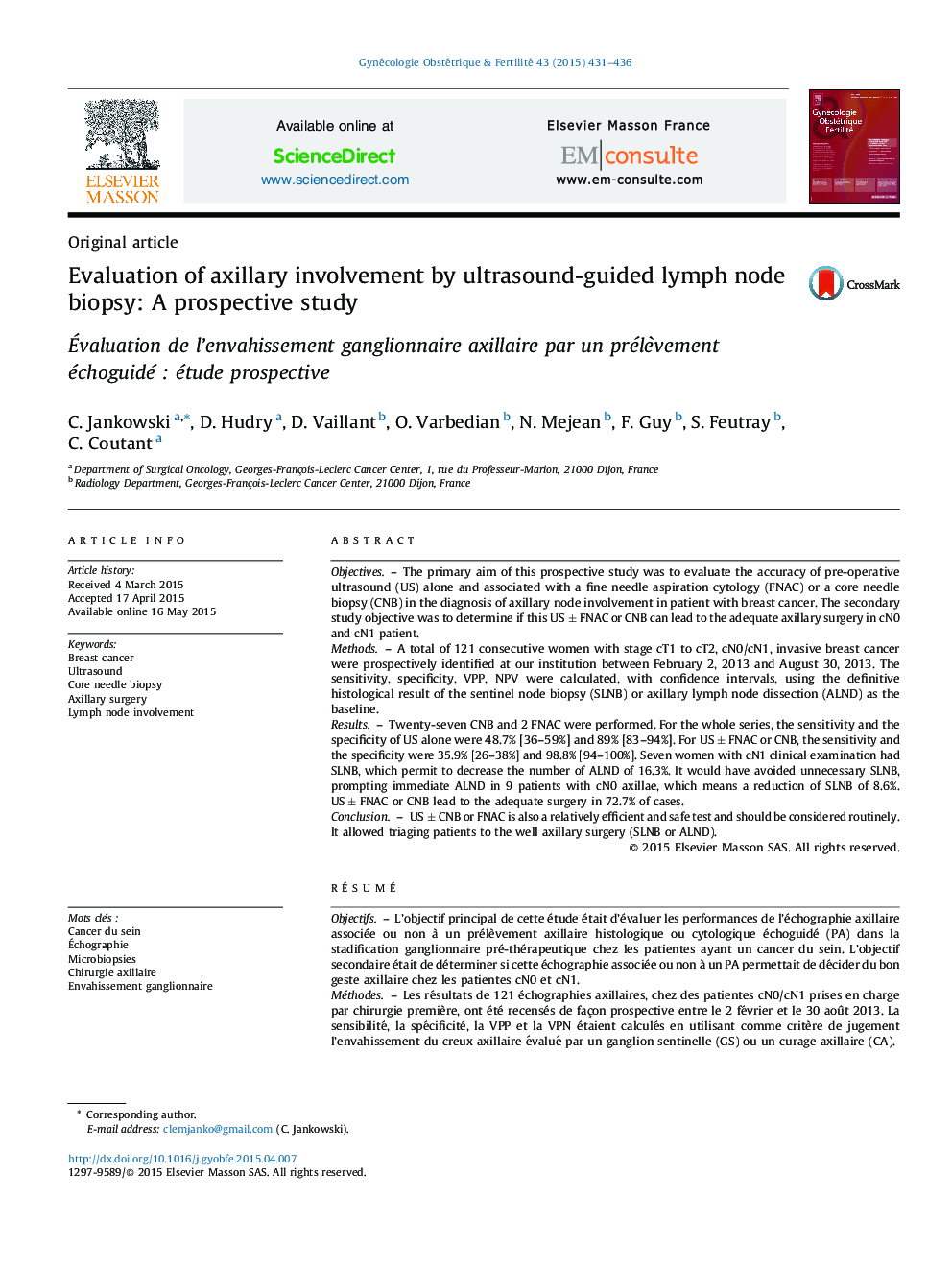| Article ID | Journal | Published Year | Pages | File Type |
|---|---|---|---|---|
| 3951357 | Gynécologie Obstétrique & Fertilité | 2015 | 6 Pages |
ObjectivesThe primary aim of this prospective study was to evaluate the accuracy of pre-operative ultrasound (US) alone and associated with a fine needle aspiration cytology (FNAC) or a core needle biopsy (CNB) in the diagnosis of axillary node involvement in patient with breast cancer. The secondary study objective was to determine if this US ± FNAC or CNB can lead to the adequate axillary surgery in cN0 and cN1 patient.MethodsA total of 121 consecutive women with stage cT1 to cT2, cN0/cN1, invasive breast cancer were prospectively identified at our institution between February 2, 2013 and August 30, 2013. The sensitivity, specificity, VPP, NPV were calculated, with confidence intervals, using the definitive histological result of the sentinel node biopsy (SLNB) or axillary lymph node dissection (ALND) as the baseline.ResultsTwenty-seven CNB and 2 FNAC were performed. For the whole series, the sensitivity and the specificity of US alone were 48.7% [36–59%] and 89% [83–94%]. For US ± FNAC or CNB, the sensitivity and the specificity were 35.9% [26–38%] and 98.8% [94–100%]. Seven women with cN1 clinical examination had SLNB, which permit to decrease the number of ALND of 16.3%. It would have avoided unnecessary SLNB, prompting immediate ALND in 9 patients with cN0 axillae, which means a reduction of SLNB of 8.6%. US ± FNAC or CNB lead to the adequate surgery in 72.7% of cases.ConclusionUS ± CNB or FNAC is also a relatively efficient and safe test and should be considered routinely. It allowed triaging patients to the well axillary surgery (SLNB or ALND).
RésuméObjectifsL’objectif principal de cette étude était d’évaluer les performances de l’échographie axillaire associée ou non à un prélèvement axillaire histologique ou cytologique échoguidé (PA) dans la stadification ganglionnaire pré-thérapeutique chez les patientes ayant un cancer du sein. L’objectif secondaire était de déterminer si cette échographie associée ou non à un PA permettait de décider du bon geste axillaire chez les patientes cN0 et cN1.MéthodesLes résultats de 121 échographies axillaires, chez des patientes cN0/cN1 prises en charge par chirurgie première, ont été recensés de façon prospective entre le 2 février et le 30 août 2013. La sensibilité, la spécificité, la VPP et la VPN étaient calculés en utilisant comme critère de jugement l’envahissement du creux axillaire évalué par un ganglion sentinelle (GS) ou un curage axillaire (CA).RésultatsVingt-sept PA ont été réalisés (25 microbiopsies et 2 cytoponctions). Sur l’ensemble de la population, la sensibilité et la spécificité étaient de 48,7 % [36–59 %], et 89 % [83–94 %] pour l’échographie seule. La sensibilité et la spécificité étaient de 35,9 % [26–38 %], et 98,8 % [94–100 %] pour l’échographie associée à un PA. Sept patientes cN1 ont pu bénéficier d’une procédure du GS, ce qui a diminué le nombre de CA de 16,3 %. Neuf patientes cN0 ont pu bénéficier d’un CA leur évitant un GS inutile. Le couple échographie associé ou non à un PA a permis de réaliser le bon geste axillaire (GS ou CA) dans 72,7 % des cas.ConclusionL’échographie axillaire associée à un PA est un examen sensible et très spécifique pour déterminer le statut axillaire et permettre de réaliser le bon geste axillaire.
